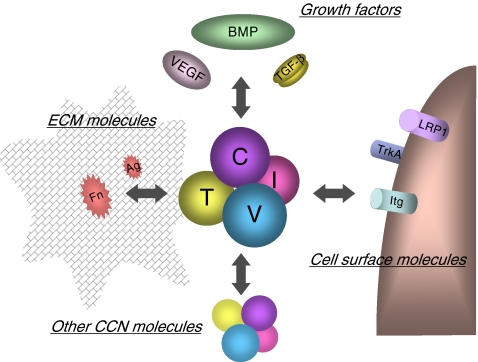Fig. 1.
Molecular action of CCN2 in cartilage. CCN2 molecule represented by the complex with 4 spheres in the center interacts with a number of biomolecules in different categories, which results in the integrated manipulation of extracellular signaling. The letters “I,” “V,” “T,” and “C” on the spheres denote insulin-like growth factor-like module, von Willebrand factor type C repeat, thrombospondin type 1 repeat and C-terminal cystine knot module, respectively. Growth factors interacting with CCN2 include transforming growth factor beta (TGF-β), bone morphogenetic proteins (BMPs) and vascular endothelial growth factor (VEGF). Binding between CCN2 and cartilaginous ECM molecules, such as fibronectin (Fn) and aggrecan, is indicated. Several cell-surface receptors present on chondrocytes as represented by integrins (Itg), low-density lipoprotein receptor related protein 1 (LRP-1) and Trk A are known to directly interact with CCN2. Of note, recent investigation is revealing the interaction of CCN2 with another CCN family member, as well as with itself

